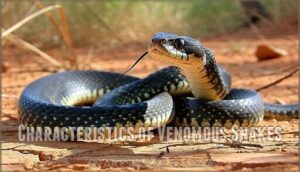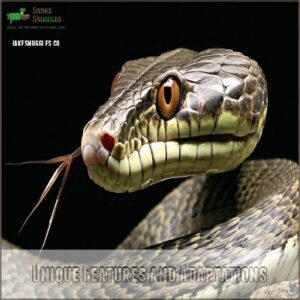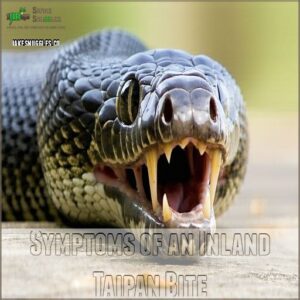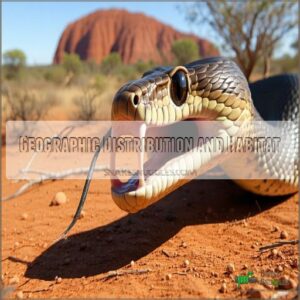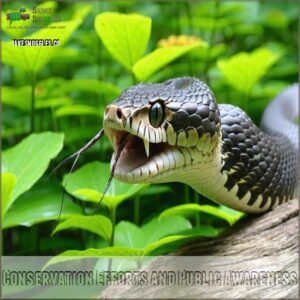This site is supported by our readers. We may earn a commission, at no cost to you, if you purchase through links.
 You’ll want to watch your step if you ever encounter the inland taipan, the most venomous snake in the world.
You’ll want to watch your step if you ever encounter the inland taipan, the most venomous snake in the world.
This Australian serpent packs enough venom in a single bite to kill 100 adults, thanks to a special enzyme that turbocharges its toxin absorption.
Its venom is 200 times more potent than the Eastern Brown Snake and 50 times deadlier than the Indian Cobra, with a lethal dose of just 0.025mg/kg.
While its power is unmatched, you might be surprised to learn how this remarkable creature has shaped modern medicine and continues to influence groundbreaking scientific discoveries.
Table Of Contents
- Key Takeaways
- Characteristics of Venomous Snakes
- The Most Venomous Snake in The World
- Venom Composition and Potency
- Symptoms of an Inland Taipan Bite
- Geographic Distribution and Habitat
- Deadly Snakes: a Global Ranking
- Factors Contributing to Deadliness
- Avoiding and Treating Venomous Snake Bites
- Impact on Human Health and Mortality
- Conservation Efforts and Public Awareness
- Frequently Asked Questions (FAQs)
- What is the most venomous snake in Australia?
- What is the longest venomous snake in the world?
- What is the deadliest snake in the world?
- What is the most venomous snake?
- Which countries have the most venomous snakes?
- How many snakes are venomous?
- What is the 1 deadliest snake in the world?
- What are the top 3 poisonous snakes?
- Which snake venom kills the fastest?
- Is the black mamba the deadliest snake in the world?
- Conclusion
Key Takeaways
- You’ll find the inland taipan is the world’s most venomous snake, with enough venom in a single bite to kill 100 adults due to its unique enzyme that speeds up toxin absorption.
- While you’ll encounter deadlier snakes like the saw-scaled viper (causing more human deaths), the inland taipan’s venom is 200 times more potent than the Eastern Brown Snake and 50 times deadlier than the Indian Cobra.
- You’ll spot these serpents exclusively in Australia’s remote semi-arid regions across Queensland, South Australia, and the Northern Territory, where they prefer to avoid human contact.
- You’ll need immediate medical attention if bitten, as symptoms appear within minutes, but the good news is that antivenom treatment has a 95% success rate when administered promptly.
Characteristics of Venomous Snakes
You’ll find that venomous snakes inject their prey with specialized toxins through hollow, needle-like fangs that can fold back against the roof of their mouths when not in use.
The venom itself contains a powerful mix of proteins and enzymes that can affect your nervous system, blood, or tissue, with some species like the inland taipan carrying enough venom in a single bite to kill 100 adults.
Definition and Explanation of Venom
Inside a snake’s venom glands, you’ll find a complex cocktail of proteins and enzymes that’s evolved over millions of years.
When delivered through specialized fangs, this potent mixture acts as a sophisticated weapon for hunting and defense.
Think of venom as a biochemical marvel that breaks down tissues, disrupts nerve signals, or interferes with blood clotting – nature’s deadliest chemical warfare system.
Types of Venom and Their Effects
Slithering through the complex world of snake venom, you’ll find two main types that pack a deadly punch.
Neurotoxins target your nervous system, causing paralysis and respiratory failure, while hemotoxins destroy blood cells and tissue.
The inland taipan’s venom combines both, making it particularly lethal.
Notably, these venoms have evolved differently across species, leading to unique cocktails that scientists are studying for medical breakthroughs.
Factors Contributing to Venom Toxicity
A snake’s venom toxicity isn’t just about its potency – it’s influenced by multiple factors that work together like a deadly symphony.
Whether you’re studying these fascinating creatures or simply want to understand them better, here are the key contributors.
You can also explore products that focus on venom snake potency supplements to learn more about this topic.
- Snake’s age affects venom concentration and composition
- Diet and prey type shape venom evolution over generations
- Environmental conditions impact venom production and potency
These factors combine to determine just how deadly a serpent’s bite can be.
The Most Venomous Snake in The World
You’ll find the inland taipan at the top of nature’s deadliest list, as a single bite from this Australian serpent contains enough venom to kill 100 adults.
While you’re unlikely to encounter one in the wild, you’ll want to know that its venom works faster than any other snake’s, thanks to a special enzyme that speeds up toxin absorption in the body.
The Inland Taipan’s Deadly Venom
While the inland taipan might seem unassuming, you’re looking at a snake whose venom packs enough punch to kill 100 humans with a single bite.
Its potent cocktail of neurotoxins acts faster than any other snake venom known to science.
| Feature | Impact |
|---|---|
| Venom Yield | 110mg per bite |
| Time to Death | 30-45 minutes |
| Lethal Dose | 0.025mg/kg |
| Survival Rate |
Comparison to Other Venomous Snakes
The Inland Taipan‘s venom stands unmatched when compared to other venomous snakes.
The inland taipan’s potent neurotoxin and procoagulant cocktail, as seen in its highly potent venom composition, sets it apart from other deadly serpents.
You’ll find its venom is 200 times more potent than the Eastern Brown Snake and 50 times deadlier than the Indian Cobra.
In LD50 tests, a single bite from this serpent contains enough venom to kill 100 humans, making it markedly more lethal than its closest rival, the coastal taipan.
Unique Features and Adaptations
Evolution has equipped the inland taipan (Oxyuranus microlepidotus) with remarkable adaptations for survival.
You’ll notice its expert camouflage that shifts seasonally from dark winter colors to lighter summer hues.
Its heat-sensing pits detect prey with pinpoint accuracy, while specialized muscles deliver the world’s fastest and most precise strike.
When threatened, it’ll showcase defensive mechanisms including a distinctive S-shaped warning pose before deploying its devastating venom.
Venom Composition and Potency
You’ll find the inland taipan’s venom loaded with a powerful mix of neurotoxins and an enzyme called hyaluronidase that helps spread toxins through your body faster than any other snake.
The venom’s incredible potency means just one bite contains enough toxins to kill 100 adult humans, making it nature’s most efficient venom delivery system.
The Role of Hyaluronidase Enzyme
Imagine a molecular key that opens your body’s defenses – that’s the hyaluronidase enzyme in snake venom.
This remarkable enzyme helps venom spread through your tissues by:
- Breaking down barriers between cells
- Increasing tissue permeability for faster absorption
- Making antivenom less effective by dispersing toxins quickly
In the inland taipan’s venom, hyaluronidase acts like a delivery system, ensuring other toxic components reach their targets efficiently.
Neurotoxins and Hemotoxins in Venom
Snake venom naturally splits into two main categories that pack different kinds of punch.
You’ll find neurotoxins targeting your nervous system and hemotoxins attacking your blood.
Here’s how they break down:
| Toxin Type | Primary Target | Key Effects |
|---|---|---|
| Neurotoxin | Nerve Cells | Paralysis |
| Hemotoxin | Blood Cells | Bleeding |
| Combined | Multiple Systems | Organ Failure |
Working alongside the spreading factor we just covered, these toxins form nature’s perfect weapon.
Measuring Venom Toxicity Using LD50
To understand just how deadly a snake’s venom is, scientists use a measurement called LD50 (Lethal Dose 50%).
This measurement is essential for developing effective antivenoms and understanding snake bite symptoms, which are essential in treating venomous bites.
You’ll see this number pop up when comparing different species – it shows how much venom it takes to be lethal in 50% of test cases.
The inland taipan’s venom ranks highest, with an LD50 of 0.025mg/kg, making it officially the world’s most venomous snake.
Symptoms of an Inland Taipan Bite
You’ll experience severe symptoms within minutes of an inland taipan bite as its powerful venom rapidly spreads through your body, causing headaches, nausea, and eventual paralysis.
Without immediate medical treatment, you’ll face a dangerous combination of blood clotting problems and muscle paralysis that can quickly become life-threatening.
Immediate Symptoms and Reactions
Time slips away rapidly after an inland taipan bite, with symptoms appearing within minutes.
You’ll notice intense pain and swelling at the bite site, followed by nausea and dizziness.
Bleeding from the wound and gums may occur as procoagulants disrupt blood clotting.
Myotoxins quickly cause muscle weakness and numbness, while neurotoxins begin affecting your breathing and heart rate.
Long-term Effects and Complications
Beyond the initial shock of a taipan bite, lasting complications can transform your life.
Venom damage continues long after treatment, affecting multiple body systems:
- Permanent nerve damage leads to chronic pain and reduced mobility in affected limbs
- Kidney failure often requires lifelong dialysis treatments
- Psychological trauma creates lasting anxiety and PTSD, particularly during outdoor activities
Research shows that even with immediate antivenom treatment, tissue necrosis and organ damage may persist for years.
Rarity of Encounters With Humans
Despite their lethal reputation, inland taipans rarely cross paths with humans, thanks to their remote habitat preferences.
Here’s a breakdown of what makes encounters so uncommon:
| Factor | Impact | Risk Level |
|---|---|---|
| Habitat | Semi-arid regions | Low |
| Activity | Dawn/dusk hunting | Minimal |
| Behavior | Naturally shy, retreats first | Very Low |
When these snakes do detect human presence, they’ll typically slip away quietly rather than confront us.
Geographic Distribution and Habitat
You’ll find the inland taipan in the remote, semi-arid regions of central Australia, where it’s adapted to survive in the harsh outback environment.
While you might expect the world’s most venomous snake to dominate a larger territory, it actually only inhabits a small range across Queensland, South Australia, and the Northern Territory.
Native Range and Geographic Location
After experiencing symptoms from an Inland Taipan bite, you’ll want to know where these serpents call home.
You’ll find these highly venomous snakes exclusively in Australia’s arid regions.
Here’s where they’re typically spotted:
- Central Australia’s semi-arid plains
- Queensland’s western Mitchell grasslands
- South Australia’s floodplains near Lake Eyre
They maintain a restricted range, primarily inhabiting remote areas where human encounters remain rare.
Preferred Environment and Climate
The inland taipan thrives in semi-arid regions where temperature and rainfall create the perfect hunting ground.
You’ll find these remarkable serpents adapting to both seasonal extremes and daily variations, similar to how anacondas and boa constrictors have adapted to their respective habitats, with boa constrictors being more arboreal and anacondas being more aquatic, according to snake habitat comparisons.
| Environmental Factor | Preferred Conditions | Tolerance Range | Impact on Behavior |
|---|---|---|---|
| Temperature | 25-35°C (77-95°F) | 15-40°C | Less active in cold |
| Rainfall | 200-400mm annually | 150-500mm | More visible after rain |
| Soil Type | Clay and cracking soils | Various | Affects burrowing depth |
| Vegetation | Sparse grassland | Mixed terrain | Influences hunting success |
These adaptable predators have mastered life in Australia’s harshest environments, where extreme weather patterns shape their daily routines.
Deadly Snakes: a Global Ranking
You’ll find that the world’s deadliest snakes aren’t always the most venomous, as the saw-scaled viper causes more human deaths than any other species despite having less potent venom.
While the inland taipan holds the title for most toxic venom, you’re more likely to encounter other dangerous serpents like the black mamba, known for its speed and aggressive defensive behavior.
The Saw-Scaled Viper’s Aggressive Nature
Moving beyond their natural range, let’s look at why saw-scaled vipers top the list of deadly snakes worldwide.
Though their venom isn’t the most potent, these small but fierce serpents cause more human deaths than any other snake species.
They’re quick to defend themselves, striking repeatedly when threatened, often displaying aggressive body language.
Their aggressive nature, combined with their widespread presence in populated areas, makes them particularly dangerous to humans and livestock.
The Black Mamba’s Speed and Agility
Slithering at speeds up to 12.5 miles per hour, black mambas reign as Africa’s fastest snakes.
You’ll find these agile hunters maneuvering through dense brush and climbing trees with remarkable precision.
Their sleek bodies, reaching lengths of 14 feet, move with fluid grace in pursuit of prey.
When threatened, they can raise a third of their body off the ground, using their incredible balance to strike with deadly accuracy.
Other Highly Venomous Snake Species
While the Black Mamba’s speed impresses, several other serpents pack a deadly punch.
You’ll find these highly venomous species across diverse habitats:
- Eastern Brown Snake: Australia’s second-most venomous snake, causing rapid paralysis
- King Cobra: World’s longest venomous snake, delivering enough venom to kill 20 people
- Tiger Snake: Australian native with neurotoxic venom that attacks the nervous system
- Death Adder: Ambush predator with venom that can cause death within six hours
Factors Contributing to Deadliness
You’ll find that a snake’s deadliness depends on multiple toxins working together in its venom, including neurotoxins that attack the nervous system and hemotoxins that destroy blood cells.
The inland taipan’s venom combines these toxins with special enzymes that help them spread quickly through your body, making it particularly lethal.
Neurotoxins and Their Effects
When venom strikes, neurotoxins launch a lightning-fast attack on your nervous system.
These microscopic assassins block nerve signals to muscles, causing paralysis that can spread throughout your body within minutes.
Your breathing muscles might shut down first, which is why snake bite victims often need immediate ventilation support.
Don’t panic though – modern antivenoms can neutralize these effects if administered quickly enough.
Hemotoxins and Their Role in Venom
Hemotoxins pack a different punch than neurotoxins in snake venom, targeting your blood and tissue.
These specialized proteins break down blood cells, disrupt clotting, and damage blood vessels.
You’ll find hemotoxins prominently in vipers and pit vipers, where they’ve evolved to help these snakes quickly immobilize and digest their prey.
Research shows these toxins can cause severe tissue damage and internal bleeding in victims.
Cardiotoxins and Cytotoxins in Venom
Beyond breaking down blood cells, snake venom harbors two more lethal weapons: cardiotoxins and cytotoxins.
These specialized proteins target your heart and cellular structure.
Cardiotoxins disrupt heart muscle function, potentially causing cardiac arrest, while cytotoxins destroy cell membranes throughout your body.
For example, the green mamba’s cardiotoxins, which are key components of its venom composition, have been found to damage myocardial cells and reduce viability.
You’ll find these toxic compounds particularly concentrated in cobra venom, making them fascinating subjects for medical research and antivenom development.
Avoiding and Treating Venomous Snake Bites
You’ll find that avoiding venomous snake bites requires basic precautions like wearing protective footwear and staying alert in snake-prone areas.
If you’re unfortunate enough to get bitten, you’ll need immediate medical attention, as effective treatment often involves specific antivenoms that target the toxins of different snake species.
Bite Prevention Strategies and Precautions
Staying safe around venomous snakes isn’t rocket science – it’s about smart preparation and awareness.
Consider investing in a snake bite kit for emergencies.
You’ll want to keep these essential precautions in mind when exploring snake territory:
- Wear thick boots and loose-fitting pants
- Stick to clear paths and avoid tall grass
- Make noise while walking to avoid snakes
- Carry a first aid snake bite kit for emergencies snake bite kit
- Never attempt to handle or provoke snakes
Following these guidelines greatly reduces your chance of a snake encounter.
First Aid for Envenomation and Wound Care
Quick action after a snake bite can mean the difference between life and death.
Keep the affected area below heart level and remove any constricting items like jewelry.
Don’t try outdated methods like sucking out venom or applying tourniquets – these can cause more harm.
Clean the wound with soap and water, mark the bite site’s swelling progression, and wrap with a pressure bandage while seeking immediate medical help.
Antivenoms and Medical Treatment Options
Modern antivenom treatment stands as your lifeline after a venomous snake bite. Medical facilities stock specialized antivenoms that target specific snake species, with treatment success rates reaching 95% when administered promptly.
- Advanced antivenom production uses purified antibodies
- Cutting-edge snake venom research improves treatment accuracy
- Smart treatment protocols adapt to patient-specific reactions
For maximum effectiveness, doctors combine antivenom therapy with supportive care like wound management, pain control, and monitoring of essential signs.
Impact on Human Health and Mortality
You’ll want to know that venomous snakes cause around 5.4 million bites worldwide each year, leading to over 81,000 deaths and countless disabilities.
If you’re living in areas with venomous snakes, you’re facing a mortality rate that’s particularly high in rural regions where medical care isn’t readily available.
Global Snakebite Statistics and Trends
Amidst our global health challenges, snakebites affect about 5.4 million people annually worldwide.
These incidents aren’t evenly distributed; they’re concentrated in regions where healthcare access is limited.
While urban areas report fewer cases, rural communities in Asia, Africa, and Latin America bear the brunt of this issue.
Research shows that agricultural workers and children face the highest risk of encounters.
Mortality and Disability Rates Due to Snakebites
Snake bites from dangerous serpents claim between 81,000 and 138,000 lives annually worldwide. Beyond these stark numbers, survivors often face life-altering disabilities that reshape their futures.
Here’s what you need to know about snake bite impacts:
- About 400,000 people experience permanent disabilities
- Limb amputations account for 50% of severe cases
- Neurological damage affects 30% of survivors
- Psychological trauma impacts 80% of victims
Socioeconomic Burden and Healthcare Costs
Beyond the devastating death toll, snake bites create a severe economic burden.
You’ll find the highest impact in rural communities, where access to treatment remains limited.
Here’s a breakdown of the financial strain across different regions:
| Region | Treatment Cost (USD) | Economic Loss/Year |
|---|---|---|
| Africa | $2,000-5,000 | $290M |
| Asia | $1,500-3,000 | $320M |
| Americas | $3,000-7,000 | $170M |
| Oceania | $4,000-8,000 | $85M |
Conservation Efforts and Public Awareness
You’ll find that protecting these remarkable creatures involves more than just avoiding them.
Scientists work to collect their venom for lifesaving medical research.
Your understanding of venomous snakes can help support essential conservation efforts that protect both these fascinating reptiles and their natural habitats.
Threats and Endangered Status of Venomous Snakes
Despite their fearsome reputation, venomous snakes face serious threats to their survival.
Habitat destruction from urban development and agriculture, direct persecution due to human fear and misunderstanding, and a lack of accessible snake bite treatment options.
Conservation efforts are essential, yet many species remain endangered or vulnerable.
Understanding these threats helps drive meaningful protection measures for these misunderstood predators.
Research and Venom Collection for Medical Use
Scientists are revolutionizing medicine through snake venom research, carefully extracting these potent compounds in specialized facilities.
You’ll find experts using sophisticated extraction methods, from manual "milking" to innovative technologies.
The venom’s components are essential for developing life-saving antivenoms and groundbreaking medications.
Clinical trials continue exploring new therapeutic applications, while ethical guidelines guarantee both snake and researcher safety during collection processes.
Public Education and Awareness Campaigns
Global awareness campaigns empower you to coexist safely with these remarkable creatures.
Organizations worldwide run educational programs that put knowledge directly in your hands.
- Join local snake identification workshops
- Download free snake safety apps
- Follow regional snake-spotting networks
- Attend community outreach events
- Access online prevention resources
Your understanding of venomous snakes doesn’t just protect you—it helps preserve these important species and their habitats.
Frequently Asked Questions (FAQs)
What is the most venomous snake in Australia?
Holy smokes, mate!
Australia’s inland taipan packs the most potent venom of any snake you’ll find Down Under.
One bite from this beauty’s got enough punch to take down 100 humans in a flash.
What is the longest venomous snake in the world?
The King Cobra stands as Earth’s longest venomous snake, reaching up to 18 feet in length.
You’ll find these magnificent creatures throughout Southeast Asia, where they’ve earned their royal title through their impressive size.
What is the deadliest snake in the world?
Saw-scaled vipers claim more lives globally than any other snake species.
They’re not the most venomous.
While they’re not the most venomous, their aggressive nature, quick strikes, and frequent encounters with humans make them particularly dangerous.
What is the most venomous snake?
Like a living lightning bolt, Australia’s inland taipan packs the world’s most potent venom.
You’ll be fascinated to know its venom contains a unique spreading factor that makes it deadlier than any other snake.
Which countries have the most venomous snakes?
Australia leads with deadly species like taipans and brown snakes, while India’s saw-scaled vipers cause many deaths.
Dangerous species are found in Africa’s savannas, South America’s rainforests, and Southeast Asia’s jungles.
How many snakes are venomous?
Out of more than 3,000 snake species worldwide, you’ll find approximately 600 venomous ones. But don’t worry too much – only about 7% of these venomous snakes are capable of seriously harming humans.
What is the 1 deadliest snake in the world?
Despite common misconceptions about the inland taipan’s potency, the saw-scaled viper claims the title of world’s deadliest snake.
Its aggressive nature and quick, frequent strikes make it responsible for more human deaths globally.
What are the top 3 poisonous snakes?
Based on their potent venom and human fatalities, you’ll find three deadly champions: the Inland Taipan leads with the most toxic venom, followed by the Eastern Brown Snake and Black Mamba in second and third.
Which snake venom kills the fastest?
The black mamba’s venom can kill within 20 minutes, making it the fastest-acting snake venom known. You’ll experience rapid respiratory failure and cardiovascular collapse if bitten by this aggressive African serpent.
Is the black mamba the deadliest snake in the world?
Actually, you’re thinking of the saw-scaled viper – it’s responsible for more human deaths than any other snake.
While black mambas are highly venomous, they don’t cause the most fatalities worldwide.
Conclusion
Understanding the most venomous snake in the world isn’t just about fear—it’s about respect and knowledge.
While the inland taipan’s venom packs an unmatched punch, its reclusive nature means human encounters are rare.
Through research of its powerful venom, scientists continue to develop life-saving medications.
Remember, these remarkable creatures play a key role in their ecosystems and medical breakthroughs, reminding us that nature’s most potent species often hold keys to healing.

